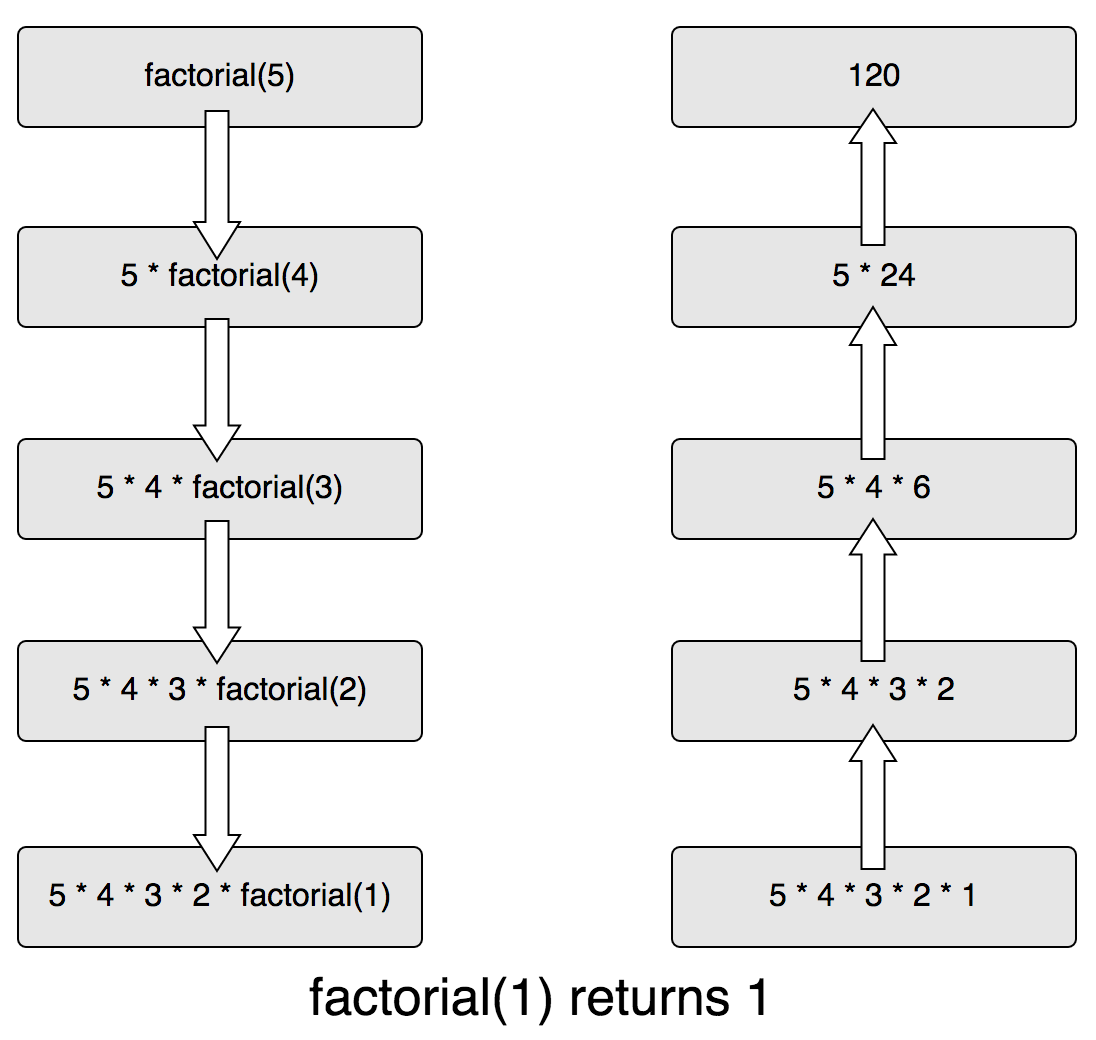Translator's Note: Programmers should know recursion, but do you really know what's going on?
Original: All About Recursion, PTC, TCO and STC in JavaScript
Translator: Fundebug
In order to ensure readability, free translation is adopted instead of literal translation.
A Brief Introduction to Recursion
> A process or function has a method to call itself directly or indirectly in its definition or description. It usually transforms a large and complex problem layer by layer into a smaller problem similar to the original problem to solve. The recursive strategy only needs a small number of programs to describe the repeated calculation needed in the process of solving the problem, which greatly reduces the amount of code in the program.
Let's take an example. We can use the factorial of 4 to define the factorial of 5, the factorial of 3 to define the factorial of 4, and so on.
factorial(5) = factorial(4) * 5 factorial(5) = factorial(3) * 4 * 5 factorial(5) = factorial(2) * 3 * 4 * 5 factorial(5) = factorial(1) * 2 * 3 * 4 * 5 factorial(5) = factorial(0) * 1 * 2 * 3 * 4 * 5 factorial(5) = 1 * 1 * 2 * 3 * 4 * 5
With Haskell's Patternmatching, factorial functions can be defined intuitively:
factorial n = factorial (n-1) * n factorial 0 = 1
In the recursive example, starting with the first call to factorial(5), the factorial function itself is called recursively until the value of the parameter is 0. Here is an image of the following:

Recursive call stack
To understand the call stack, let's go back to the factorial function example.
function factorial(n) { if (n === 0) { return 1 } return n * factorial(n - 1) }
If we pass in parameter 3, factorial(2), factorial(1) and factorial(0) will be called recursively, so factorial will be called three more times.
Each function call is pushed into the call stack. The whole call stack is as follows:
factorial(0) // The factorial of 0 is 1. factorial(1) // The call depends on factorial(0) factorial(2) // The call depends on factorial(1) factorial(3) // The switch depends on factorial(2)
Now let's modify the code and insert console.trace() to see the status of each current call stack:
function factorial(n) { console.trace() if (n === 0) { return 1 } return n * factorial(n - 1) } factorial(3)
Next, let's look at the call stack. First:
Trace at factorial (repl:2:9) at repl:1:1 // Ignore the following underlying implementation details at realRunInThisContextScript (vm.js:22:35) at sigintHandlersWrap (vm.js:98:12) at ContextifyScript.Script.runInThisContext (vm.js:24:12) at REPLServer.defaultEval (repl.js:313:29) at bound (domain.js:280:14) at REPLServer.runBound [as eval] (domain.js:293:12) at REPLServer.onLine (repl.js:513:10) at emitOne (events.js:101:20)
You will find that the call stack contains a call to the factorial function, which is factorial(3). Next, more interesting, let's look at the second printed call stack:
Trace at factorial (repl:2:9) at factorial (repl:7:12) at repl:1:1 // Ignore the following underlying implementation details at realRunInThisContextScript (vm.js:22:35) at sigintHandlersWrap (vm.js:98:12) at ContextifyScript.Script.runInThisContext (vm.js:24:12) at REPLServer.defaultEval (repl.js:313:29) at bound (domain.js:280:14) at REPLServer.runBound [as eval] (domain.js:293:12) at REPLServer.onLine (repl.js:513:10)
Now we have two calls to factorial functions.
Third time:
Trace at factorial (repl:2:9) at factorial (repl:7:12) at factorial (repl:7:12) at repl:1:1 at realRunInThisContextScript (vm.js:22:35) at sigintHandlersWrap (vm.js:98:12) at ContextifyScript.Script.runInThisContext (vm.js:24:12) at REPLServer.defaultEval (repl.js:313:29) at bound (domain.js:280:14) at REPLServer.runBound [as eval] (domain.js:293:12)
Fourth time:
Trace at factorial (repl:2:9) at factorial (repl:7:12) at factorial (repl:7:12) at factorial (repl:7:12) at repl:1:1 at realRunInThisContextScript (vm.js:22:35) at sigintHandlersWrap (vm.js:98:12) at ContextifyScript.Script.runInThisContext (vm.js:24:12) at REPLServer.defaultEval (repl.js:313:29) at bound (domain.js:280:14)
Imagine that if the value of the parameter passed in is particularly large, the call stack will be very large and may eventually crash beyond the cache size of the call stack, causing the program to fail to execute. So how to solve this problem? Use tail recursion.
Tail recursion
Tail recursion is a recursive way of writing, which can avoid the stack overflow caused by constantly stacking functions. By setting a cumulative parameter and adding the current value each time, it is called recursively.
Let's see how to rewrite the previous definition of factorial function as tail recursion:
function factorial(n, total = 1) { if (n === 0) { return total } return factorial(n - 1, n * total) }
The implementation steps of factorial(3) are as follows:
factorial(3, 1) factorial(2, 3) factorial(1, 6) factorial(0, 6)
The call stack no longer needs to stack factorial multiple times, because each recursive call does not depend on the value of the previous recursive call. Therefore, the complexity of space is o(1) instead of 0(n).
Next, the call stack is printed out through the console.trace() function.
function factorial(n, total = 1) { console.trace() if (n === 0) { return total } return factorial(n - 1, n * total) } factorial(3)
Surprisingly, there are still many stacks!
// ... // Here are the last two calls to factorial Trace at factorial (repl:2:9) // 3 times stack at factorial (repl:7:8) at factorial (repl:7:8) at repl:1:1 // Ignore the following underlying implementation details at realRunInThisContextScript (vm.js:22:35) at sigintHandlersWrap (vm.js:98:12) at ContextifyScript.Script.runInThisContext (vm.js:24:12) at REPLServer.defaultEval (repl.js:313:29) at bound (domain.js:280:14) at REPLServer.runBound [as eval] (domain.js:293:12) Trace at factorial (repl:2:9) // Finally, the first call pushes the stack again at factorial (repl:7:8) at factorial (repl:7:8) at factorial (repl:7:8) at repl:1:1 // Ignore the following underlying implementation details at realRunInThisContextScript (vm.js:22:35) at sigintHandlersWrap (vm.js:98:12) at ContextifyScript.Script.runInThisContext (vm.js:24:12) at REPLServer.defaultEval (repl.js:313:29) at bound (domain.js:280:14)
Why is that? Under Nodejs, we can turn on proper tail call by opening strict mode and using -- harmony_tailcalls.
'use strict' function factorial(n, total = 1) { console.trace() if (n === 0) { return total } return factorial(n - 1, n * total) } factorial(3)
Use the following commands:
node --harmony_tailcalls factorial.js
The call stack information is as follows:
Trace at factorial (/Users/stefanzan/factorial.js:3:13) at Object.<anonymous> (/Users/stefanzan/factorial.js:9:1) at Module._compile (module.js:570:32) at Object.Module._extensions..js (module.js:579:10) at Module.load (module.js:487:32) at tryModuleLoad (module.js:446:12) at Function.Module._load (module.js:438:3) at Module.runMain (module.js:604:10) at run (bootstrap_node.js:394:7) at startup (bootstrap_node.js:149:9) Trace at factorial (/Users/stefanzan/factorial.js:3:13) at Object.<anonymous> (/Users/stefanzan/factorial.js:9:1) at Module._compile (module.js:570:32) at Object.Module._extensions..js (module.js:579:10) at Module.load (module.js:487:32) at tryModuleLoad (module.js:446:12) at Function.Module._load (module.js:438:3) at Module.runMain (module.js:604:10) at run (bootstrap_node.js:394:7) at startup (bootstrap_node.js:149:9) Trace at factorial (/Users/stefanzan/factorial.js:3:13) at Object.<anonymous> (/Users/stefanzan/factorial.js:9:1) at Module._compile (module.js:570:32) at Object.Module._extensions..js (module.js:579:10) at Module.load (module.js:487:32) at tryModuleLoad (module.js:446:12) at Function.Module._load (module.js:438:3) at Module.runMain (module.js:604:10) at run (bootstrap_node.js:394:7) at startup (bootstrap_node.js:149:9) Trace at factorial (/Users/stefanzan/factorial.js:3:13) at Object.<anonymous> (/Users/stefanzan/factorial.js:9:1) at Module._compile (module.js:570:32) at Object.Module._extensions..js (module.js:579:10) at Module.load (module.js:487:32) at tryModuleLoad (module.js:446:12) at Function.Module._load (module.js:438:3) at Module.runMain (module.js:604:10) at run (bootstrap_node.js:394:7) at startup (bootstrap_node.js:149:9)
You'll find that you don't stack every call, there's only one factorial.
Note: Tail recursion does not necessarily increase the speed of your code execution; on the contrary, tail recursion does not necessarily increase the speed of your code execution. It may slow down. . However, tail recursion allows you to use less memory and make your recursive functions safer (provided you turn on harmony mode).
So the blogger wonders: Why does tail normalization have to turn on harmony mode? Welcome to join the discussion.
Welcome to join us We Fundebug Full stack BUG monitoring communication group: 622902485.

Copyright Statement: When reproducing, please indicate the author Fundebug and the address of this article: https://blog.fundebug.com/2017/06/14/all-about-recursions/
Did your users encounter BUG?